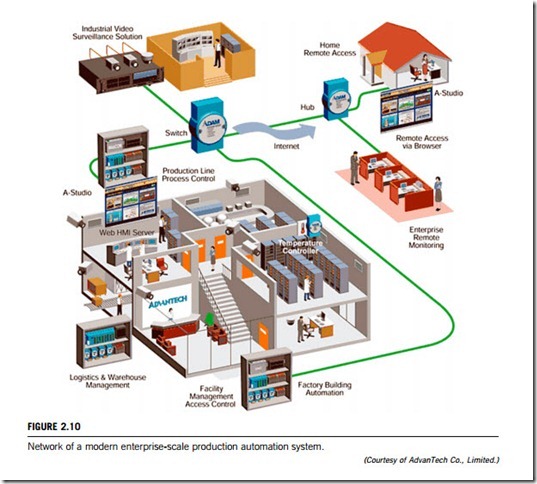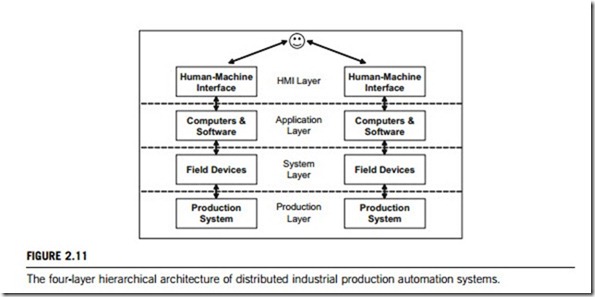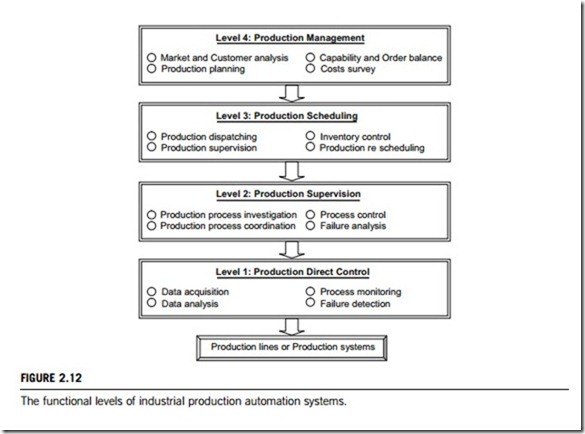INDUSTRIAL PRODUCTION AUTOMATION
Definition and functions
The term industrial automation generally refers to the science and technology of process control and automatic machinery assembly in any industry. Industrial process control is discussed in section 2.1 of this textbook. This section discusses automatic machinery assembly, termed industrial production automation.
Industrial production automation is the use of computers, programmable numerical controllers and robots to complete machinery assembly in industry, particularly necessary advanced production systems. Such a production system will consist of a number of machines organized together to perform multiple operations. These machines function as manufacturing cells, which comprise all the operations required to manufacture a given product or group of products. Instead of being organized functionally all of the stamping equipment located in one specific area, for example manufacturing cells contain all of the machines and personnel necessary to create a product in one prescribed space, beginning with the raw materials and ending with the finished product. The proximity of machines in a manufacturing cell cuts down on the waste that comes from having to transport materials from one place to another, and offers workers an opportunity to be cross-trained on a variety of machines. They are often used to streamline and automate material removal processes. There are many industrial robotic machines that can be integrated with deburring, grinding, and cutting machines to facilitate this. Material removal cells can also include ventilation parts and small fume removal cells. A small fume removal cell is often used to remove smoke or mist, or to collect dust. These manufacturing cells are also used in welding, sanding, and other high-speed machining processes.
There are three main flows that determine the organization of industrial production systems; material flow, energy flow, and information flow. The basic objective of industrial production automation is to identify the information flow, and to manipulate the material and energy flows of a given production system in the desired, optimal way. This is usually a compromise between economic, social and quality factors in order to obtain maximum benefits. The most common benefits of industrial production automation are:
(a) increasing productivity;
(b) reducing production costs;
(c) improving product quality and reliability;
(d) optimizing production flexibility and production schedules;
(e) enhancing production safety;
(f) controlling pollution of the environment due to production.
Productivity can be increased, either by better use of available production capabilities, for example by moving plant bottlenecks, or by production acceleration, i.e., by making the production process faster. When using computers, controllers and robots, production volume can be increased by running the production sequence up to the highest allowable limits of some critical variables, whilst continuously monitoring their actual values and their trends.
Production costs can be reduced by saving raw material, energy, labor, and by accelerating the process. Industrial production automation using computers, controllers and robots has two aims; saving labor in production, and reducing production time.
Product quality can be improved by better supervision of the production sequences, and improved engineering tools and conditions. On one hand, this is achieved by keeping the run-time conditions of the production system within tolerance limits. On the other hand, mathematical models of production processes allows online adjusting of relevant parameters when raw material properties or ambient conditions are changed. However, quality increase depends largely on the ability to measure the quality itself, which can be rather timing-consuming. Product reliability generally depends an product quality, so is generally thought of as a quality indicate.
Production flexibility is the major requirement for a system working under changing engineering conditions. Typical examples are batch-production, where frequent change between products is generally necessary, especially in the chemical, biochemical and petrochemical industries. The role of computer or controller in this case is to provide better production scheduling. Robots provide the automatic production. If computers, controllers and robots are combined properly, optimal utilization of available facilities and better control are readily enabled.
Production safety can be improved by production automation to prevent workers becoming victims of production accidents. In most industrial examples, the more automatic a production process is, the fewer workers are required in the production process. Industrial production automation solves both production reliability and safety problems by exact control of process conditions; or in batch processes, by exact execution of the required successive steps, by vigilant process monitoring and by timely prediction of possible hazardous situations.
Industrial production automation is different from mechanization. In mechanization, human operators run the machinery. But in production automation, most of the work is facilitated by computers, controllers or robots. This raises social issues, particularly for populous countries. Industrial automation affects employment to a great extent unskilled labor, especially, since automated industries require only skilled laborers.
This does tend to have a cathartic effect on the working population. It forces people to take up skilled jobs, or makes them try to do so. Nowadays industrial production automation is very advanced, and has even replaced many skilled jobs. It is advancing rapidly throughout the world, and may in future affect more and more skilled jobs.
In spite of all these repercussions there is a greater emphasis on industrial production automation. Initially its main purpose was to maximize production, but now focus has a shifted to enhanced product quality. Industrial production automation has also made the workforce more flexible, and it is now quite feasible to switch over from one product to another.
Once the need for automation is understood, at least two questions should be asked. What are the aims of your automation? How can they be realized under the given engineering conditions? Some- times, neither question can be fully answered. Automation aims are frequently difficult to define due to conflicting requirements; arising from complex energy, raw material, and product sale markets. Also, there may be several limitations within the production system itself. Even where the automation aims can be clearly defined, implementation decisions will have to be made based on economic factors and on the possible disruption of production during the installation of the automation process. There are three kinds of basic approach to industrial production automation.
(1) Partial production automation, which first removes the bottlenecks within a production system, and then gradually extends to complete production automation without total factory or plant or workshop shutdown: this is called a bottom-up approach.
(2) Complete production automation, usually suitable for the installation of new production systems, is generally known as the top-down approach.
(3) Integrated production automation functionally interconnects process control, supervisory, and commercial computers, which are available within the production system to increase production transparency, correctly plan strategy, and properly analyze markets.
Modern industrial production automation often involves networks on an enterprise scale, thus necessitating complicated engineering systems. Figure 2.10 is an illustration of such a network for an industrial production automation system. From this figure, we can get some insight into the complexity of industrial production automation systems.
Systems and components
Since the accelerated development in the twentieth century, industrial production automation has become a mature technology with wide application. The early system were off-line and closed-loop; the production processes and systems were completely separated from the operators. Later, these
off-line and closed-loop architectures were replaced by on-line and open-loop systems, in which operators interacted with production systems for monitoring and control purposes. Nowadays, modern industrial production automation can be characterized by two features:
(1) Computerized control technologies
The hardware of computerized technologies in industrial production automation are with numerical computers, intelligent and programmable controllers consisting of microprocessors and large-scale integrated circuits. The software elements are real-time operating systems and application-specific software systems. Computerized technologies offer digital and numerical capabilities which have allowed industrial production automation to attain greater speed and flexibility, promoting many new applications.
(2) Distributed system architectures
The control elements of a distributed architecture that are most commonly used are on-line and open- loop technologies. The most common elements configuration are multi-agents and networks. Distributed industrial automation systems reside in open networks of remote interactions and communications. They give industrial production large-scale and remote production lines over factories and plants, by using networks.
Hierarchical Architecture
Although there are some different approaches, modern industrial production automation systems adopt the following four-layer hierarchical model. As shown in Figure 2.11, these four layers are the human machine interface (HMI) layer, the application layer, the system layer, and the production layer.
(1) HMI layer
There is an extensive mixture of human and machine labor in actual manufacturing and production systems. This situation, while desirable for its agility, poses some difficulties for efficient cooperation between humans and machines. The HMI consequently becomes very important to optimize the capabilities of installed production machines, in cooperation with their human operators. This layer captures all the abstractions in the development and operational phases of HMI modules, and is supported by open and commercially available platforms and tools. However, human interactions with these platforms and tools must be considered.
(2) Application layer
This layer includes the software used in the analysis, design and implementation of applications. Based on the communication model, this layer allows an application program to ensures effective communication with other application programs in a distributed open-system. The application layer makes sure that the other party is identified and can be reached, authenticates either the message sender or receiver or both, ensures agreement at both ends about error recovery procedures, data integrity, and privacy, and determines protocol and data syntax rules at the application level.
(3) System layer
This layer includes the analysis, design and implementation of the system components. Implementations include the Fieldbus segments, the field devices, the microprocessors and other intelligent electronic units, and the network used for the real-time interconnection of Fieldbus segments. The design principles of this layer include the abstractions to support the assignment and distribution of the applications. These abstractions play the role of proxies of the actual real-world objects in the developer’s workspace.
(4) Production layer
Real production lines, including boilers, valves, motors, etc., are the actual plant components that constitute the implementation objects of this layer. The design representations of the real-world objects form the design diagram of the controlled manufacturing process, usually drawn as pipe and instrumentation diagrams.
In additional to the four-layer hierarchical model, industrial automation experts also recommend a functional levels model, in which automation is divided vertically into four levels; management, scheduling, supervision, and direct control. As shown in Figure 2.12, at each level some automation functions are implemented, which operate on the next level down. For instance, the lowest automation level, the production direct control level, interacts through appropriate interfaces with the instrumentation on the production lines such as sensors and actuators. Its algorithms will be supplied by the next level up, i.e., by the production supervision level.
Components of a Production Automation System
Computerized and distributed production automation systems include these basic components:
(1) Hierarchical database
Industrial production automation requires dynamic large-scale information data at all its function levels. However, before the database was commonplace, data had to be stored in files. Early file management systems for industrial automation were designed to allow programmers to create, store, update and read files. In the earliest attempt to abstract the programs from the underlying physical data structures, indexed files were introduced to provide access to data via indexed keys. In early file management systems, a typical historic log file would be indexed by tag name, and data could be retrieved provided the tag name is known. Indexed files still had the limitations of a flat structure with a single point of access. For instance, a programmable logic controller (PLC) can manage data in a similar way, allowing programs to access the current value of a tag by reading a register within the
PLC. Programs need to know the exact location of data on the disk, and complex algorithms are required to compute these unique addresses.
Hierarchical databases were developed to address this limitation. These databases arrange data elements in strict hierarchies, where one category of data is a subset of another. For example, an industrial plant has several production lines, each production line has a number of machines, and each machine has many measurements (or tags) associated with it. With a hierarchical database, a query for data unrelated to the functional breakdown of the plant described above, but related to a specific product or batch or engineering unit, would be both complex and inefficient.
Since the world is not hierarchical, network databases that could accommodate more complex network relationships began to appear. Although programs were less dependent on physical data structures, they still needed to know how to navigate these structures, and were susceptible to any changes. Most of the production information management systems (PIMS) available today are based on hierarchical or network data models, and are subject to the limitations of these models. The network database is the best solution yet developed to minimize these limitations.
(2) Automation controllers and software
Embedded automation computers fulfil the needs of mission-critical automation applications. Their design, industrial features, embedded operating system (OS) and powerful computing technology deliver reliability and flexibility. Automation controllers and their software include programmable automation controllers, distributed data acquisition and control systems, analog input/output modules, digital input/output modules, counter/frequency modules, communication modules, specific modules, and power supplies.
(3) Open HMI platforms
HMI platforms for automation needs include industrial panel PCs, industrial workstations, industrial monitors and touch panel computers, and so on.
(4) Industrial communication systems
Industrial communication series include industrial Ethernet switches, serial device servers, media converters, and multiple-port serial I/O cards. Advanced technology provides robust communication devices and cost-effective ways to manage network efficiency and other connected field devices.
Robotics and automation
Modern manufacturing set-ups rely increasingly on automation technology. Modern production systems are becoming more and more autonomous, requiring less operator intervention in normal operation. It is now common to have all equipment on the workshop floor connected by an industrial network to other factory resources. This requires use of computers for control and supervision of production systems, industrial networks and distributed software architectures. It also requires application software that is designed to be distributed on the workshop floor, taking advantage of the flexibility provided by using programmable controllers.
Production automation has posed problems, arising from the characteristics of the production pieces, e.g., non-flat objects with highly reflective surfaces, those very difficult to grasp and handle due to external configuration, heavy or fragile objects, pieces with extensive surfaces that are sensitive to damage, pieces with a high requirement for surface smoothness etc. Production set-ups for these types of products require high quality and low cycle times, since industries must maintain high production rates to remain competitive. Another restriction relates to the fact that most industries change products frequently due to trends, competition, etc. Lastly, there is the mixture of automatic and human labor production, which poses its own problems.
Robots with industrial software are key to solving the problems given above. In industry, robotics and automation are closely linked in the design and implementation of intelligent machines to carryout work too dirty, too dangerous, too precise or too tedious for humans. They also push the boundary of the level of intelligence and capability for many forms of autonomous or semi-autonomous machines. Robots are used in medicine, defense, space and underwater exploration, service industries, disaster relief, manufacturing and assembly and entertainment.
(1) Industrial robot types
Industrial robots are those numerical control systems that can be automatically controlled, and are reprogrammable, multipurpose manipulators that can move along in three or more axes. Some robots are programmed to carry out specific action repeatedly without variation, and with a high degree of accuracy. These actions are determined by programmed routines that specify the direction,
2.3 Industrial production automation 69
acceleration, velocity, deceleration, and distance of a series of coordinated motions. Other robots are much more flexible as to the orientation of the object; for example, for more precise guidance, robots are capable of machine vision sub-systems acting as their “eyes”, linked to powerful computers or controllers. Artificial intelligence, or what passes for it, becomes an increasingly important factor in the modern industrial robot. Industrial robots are basically of the following types:
(a) articulated robots having arms with three rotary joints;
(b) Cartesian robots (rectangular coordinate robots, rectilinear robots) having three prismatic joints whose axes are coincident with a Cartesian (X, Y, and Z) coordinate system;
(c) gantry robots, which are a type of Cartesian robot that is suspended from an X or X/Y axis beam;
(d) cylindrical robots operate in a cylinder-shaped space or coordinate system and have at least one rotary joint and at least one prismatic joint;
(e) parallel robots such as hexapods having multiple arms, each of which has three concurrent
prismatic joints; selectively compliant arm for robotic assembly robots are cylindrical and have two parallel joints to provide compliance in one selected plane;
(f) spherical robots have an arm with two rotary joints and one prismatic joint; the axes of a spherical
robot form a polar coordinate system.
(2) Industrial robot applications
Industrial robots are used across a wide spectrum of industrial applications. Typical examples include:
(a) material handling; including pick and place, dispensing, palletizing, press tending, part transfer, machine loading, machine tending, and packaging, etc.;
(b) welding: including arc welding, spot welding, robot laser welding, resistance welding, plasma
cutting, flux cored welding, and electron beams, etc.;
(c) miscellaneous: for instance grinding, drilling, thermal spraying, bonding and sealing, painting automation, deburring, robotic coating, robotic assembly, material removal, flame spray, polishing, etc.


